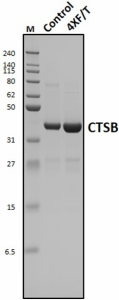- Regulatory Status
- RUO
- Other Names
- CTSB, CPSB, APP secretase, APPS, Cathepsin B1, Epididymis Secretory Sperm Binding Protein, Amyloid Precursor Protein Secretase

-

Stability Testing for Recombinant Human CTSB. One aliquot (Control) was stored at 4°C for 7 days, while another aliquot (4XF/T) was subjected to multiple freeze-thaw cycles by freezing at -80°C and thawing four times over a 7-day period. Each freeze-thaw cycle involved placing the sample on ice and slowly thawing it until no ice crystals remained in the tube. A minimum of 24 hours elapsed between each freeze and thaw event. Following treatment, the reduced samples (4 µg/lane) were separated by SDS-PAGE and stained with Coomassie brilliant blue dye. Lane M: Protein ladder (Cat. No. 773302).
| Cat # | Size | Price | Quantity Check Availability | ||
|---|---|---|---|---|---|
| 557716 | 100 µg | $300.00 | |||
Cathepsin B (CTSB) is a lysosomal cysteine protease. While most cathepsins are exclusively endopeptidases, CTSB exhibits both carboxypeptidase and endopeptidase activities. Cystatin C has been identified as an endogenous CTSB inhibitor. High CTSB protein levels and activities have been found in many tumors including breast, cervix, colon, stomach, glioma, lung, and thyroid tumors. CTSB can be secreted by tumor cells and is associated with the cell membrane of these cells. Membrane associated CTSB promotes extracellular matrix (ECM) degradation contributing to cancer motility and invasion. Many ECM proteins, including laminin, fibronectin, and collagen IV, are substrates of CTSB. CTSB can also activate pro-uPA/PLAU. Activated uPA promotes ECM digestion through serine protease plasminogen. Inhibition of CTSB can limit bone metastasis in breast cancer, making it an important anti-cancer drug target. CTSB has been proposed as a new drug target for Alzheimer's disease because of its involvement in the production of neurotoxic β-amyloid (Aβ) peptides. In a mouse model of Alzheimer’s, CTSB inhibition reduces brain Aβ peptides and improves memory. CTSB also plays significant roles in immune responses including both T and B cell apoptosis and Th1/Th2 polarization. Furthermore, CTSB is implicated in other pathological conditions including cardiovascular disease, multiple sclerosis, and arthritis. Roles of CTSB in autophagy, adipogenesis, and cholesterol absorption in the intestine have also been studied.
Product Details
- Source
- Human Cathepsin B, amino acids (Arg18-Ile339) (Accession# P07858) with a N-terminal 6His tag, was expressed in E.coli
- Molecular Mass
- The 350 amino acid recombinant protein has a predicted molecular mass of approximately 38.89 kD. The DTT-reduced and non-reduced protein migrates at approximately 31-50 kD by SDS-PAGE.
- Purity
- > 85% as determined by Coomassie stained SDS-PAGE.
- Formulation
- Protein is formulated in 50 mM HEPES, 300 mM NaCl, 5% glycerol, pH 7.5
- Concentration
- 100 µg at 0.5 mg/mL
- Storage & Handling
- Unopened vial can be stored between 2°C and 8°C for up to 1 week, at -20°C for up to three months, or at -70°C or colder until the expiration date. For maximum results, quick spin vial prior to opening. The protein can be aliquoted and stored at -20°C or colder. Stock solutions can also be prepared at 50 - 100 µg/mL in appropriate sterile buffer, carrier protein such as 0.2 - 1% BSA or HSA can be added when preparing the stock solution. Aliquots can be stored between 2°C and 8°C for up to one week and stored at -20°C or colder for up to 3 months. Avoid repeated freeze/thaw cycles.
- Application
-
Standard
- Application Notes
-
BioLegend carrier-free recombinant proteins provided in liquid format are shipped with dry ice. Our comparison testing data indicates that when handled and stored as recommended, the liquid format has equal or better stability and shelf-life compared to commercially available lyophilized proteins after reconstitution. Our liquid proteins are validated in-house to maintain activity after shipping on blue ice and are backed by our 100% satisfaction guarantee. If you have any concerns, contact us at tech@biolegend.com.
Antigen Details
- Structure
- Monomer
- Distribution
-
Cathepsin B is ubiquitous expressed and is normally localized to lysosomes. However, it can also be secreted by many cells including tumor cells, macrophages, fibroblasts, osteoclasts, T lymphocytes, and neutrophils
- Function
- Cathepsin B is a lysosomal cysteine protease that is normally involved in intracellular protein turnover
- Interaction
- Hepatitis B spliced protein, Bikunin, and TSRC1
- Cell Type
- Fibroblasts, Lymphocytes, Macrophages, Neutrophils, Osteoclasts, T cells
- Biology Area
- Immuno-Oncology, Immunology, Innate Immunity, Signal Transduction
- Molecular Family
- Innate Immune Signaling, Proteases
- Antigen References
-
- Tang Q, et al. 2021. EMBO J. 40:e107204.
- Nakanishi M, et al. 2019. Cell. 177:910-924.e22.
- Peng T, et al. 2021. Front Immunol. 12:735643.
- Kumar A, et al. 2018. J Cell Sci. 131.
- Tong B, et al. 2014. Clinical and Experimental Immunology. 177:586-97.
- Gene ID
- 1508 View all products for this Gene ID
- UniProt
- View information about Cathepsin B on UniProt.org
